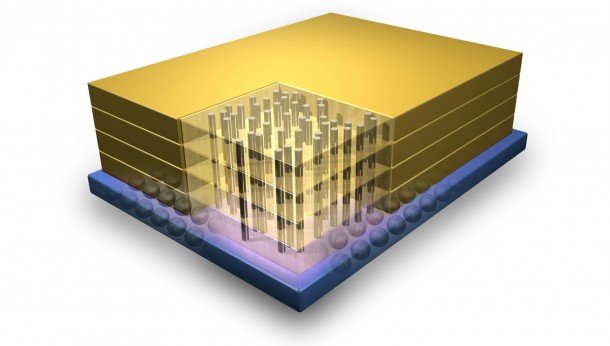Hybrid Memory Cube: after the revolution, your memory will be made of this

Hybrid Memory Cube. It's a revolution! It's a whole new take on... system memory. Damn, that's most of the readers tuning out. But you there! Yes, you, the one reader who's stayed behind because Hybrid Memory Cube sounds kinda like something the Borg might use to replay Locutus' greatest hits - let me tell you all about it.
First, let me hit you with the really important stat. A single Hybrid Memory Cube (HMC) module should deliver fifteen times the performance of a single DDR3 module. And it will do it using less energy and much, much less space.
According to the HMC Consortium - a group of companies gathered together to try and nail down a global standard for this new type of memory - modern technology has hit a wall. The improvements being sought for traditional DRAM are getting harder and harder to achieve and so we're seeing only very slight boosts to energy efficiency and bandwidth. This is seen as a barrier to progress at a system level.
The move to DDR4 memory, which we'll possibly see next year, is only going to provide small improvements to performance and efficiency. The HMC Consortium calls this an evolution compared to the revolutionary nature of Hybrid Memory Cube.
The HMC Consortium has now finalised the spec for HMC, and this standardisation means that companies now have a point from which to begin designs for future products which can incorporate HMC technology. Given that two of the big-hitters behind HMC - namely Samsung and Micron - are both huge names in system memory it's no surprise that it's taken them just seventeen months to move from the consortium's inception to a finalised standard.
“This milestone marks the tearing down of the memory wall,” claims Micron's VP for DRAM marketing, Robert Feurle.
And, to be fair, the way a HMC module is built is radically different from traditional DRAM. There's a small logic layer at the base of the cube, with stacks of DRAM dies arranged one on top of the other above it. Passing through all of these layers are direct connects through the silicon itself.
Keep up to date with the most important stories and the best deals, as picked by the PC Gamer team.
Because of the stacked nature of the HMC it is estimated that a module of this sort will take up almost 90% less space than existing memory DIMMs. And with them also having that headline-grabbing 15x performance boost, as well as needing around 70% less energy per bit compared with existing DRAM tech, the claims to revolutionary status sure seem to hold up.
It's going to be a while before we actually see the fruits of the Hybrid Memory Cube Consortium in our desktop machines, but the benefits to system memory as well as graphics memory could be huge. And a finalised standard is at least a pretty good start.

Dave has been gaming since the days of Zaxxon and Lady Bug on the Colecovision, and code books for the Commodore Vic 20 (Death Race 2000!). He built his first gaming PC at the tender age of 16, and finally finished bug-fixing the Cyrix-based system around a year later. When he dropped it out of the window. He first started writing for Official PlayStation Magazine and Xbox World many decades ago, then moved onto PC Format full-time, then PC Gamer, TechRadar, and T3 among others. Now he's back, writing about the nightmarish graphics card market, CPUs with more cores than sense, gaming laptops hotter than the sun, and SSDs more capacious than a Cybertruck.

